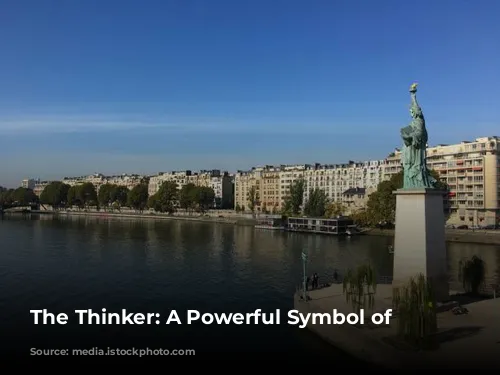Auguste Rodin’s iconic sculpture, The Thinker, captures the essence of deep thought and contemplation. This captivating figure, a nude male lost in a moment of profound introspection, has captivated audiences for generations. While The Thinker is known worldwide, the most famous version resides in the Rodin Museum in Paris, a monumental bronze statue standing an impressive six feet tall.

From the Gates of Hell to Individual Fame
Initially conceived as part of The Gates of Hell, a colossal project commissioned for a planned museum in Paris, The Thinker was originally titled The Poet. Rodin drew inspiration from Dante’s Inferno and modeled a series of small clay figures representing the poem’s tormented characters. However, the museum was never built, and the Gates of Hell were not cast during Rodin’s lifetime. We can glimpse his vision in the original plaster model at the Musée d’Orsay and the posthumously created gates, where a smaller version of The Poet sits above the entrance. This version depicts a nude figure seated on a rock, his back hunched, brows furrowed, chin resting on his hand. The Poet’s contemplative gaze seems to focus on the suffering figures of Dante’s Hell below.
While some scholars suggest the original Poet represented Dante, the muscular, powerful figure contrasts with traditional portrayals of the poet, who is typically depicted as slender and delicate.

A Legacy of Monumental Proportions
When the museum project was abandoned, Rodin continued to rework the figures from The Gates of Hell, showcasing them individually and giving some new identities. He renamed The Poet to The Thinker and presented it as a standalone sculpture in 1888. He then created larger bronze versions in the early 1900s. Rodin’s assistants, led by Henri Lebossé, expertly enlarged the original clay figures using a Collas machine. This ingenious tool, resembling a lathe, utilized a pantograph system to create exact replicas of varying sizes.
The Thinker’s monumental size, larger than life, and its separation from The Gates of Hell made a powerful statement. The sculpture’s unfinished surfaces, a style that Rodin favored, further enhance its impactful presence. The rough modeling of the clay, visible in the figure’s closely cropped hair, contributes to the work’s raw, emotional power.
The Thinker was first shown at the 1904 Salon, an annual French art exhibition. Its size and presence captivated the public, leading to a petition for its acquisition. In 1906, the French government purchased the sculpture and presented it to the city of Paris, where it was installed outside the Panthéon. In 1922, it found its permanent home in the gardens of the Rodin Museum.

A Universal Symbol of Contemplation
Rodin actively encouraged the widespread distribution of his art, authorizing numerous copies of his works in marble and bronze during his lifetime. He also granted the Rodin Museum the right to create posthumous editions. Today, The Thinker stands as a testament to Rodin’s enduring legacy, with monumental versions found in cities across the globe, including San Francisco, Cleveland, Philadelphia, Buenos Aires, Moscow, and Tokyo. Even Rodin and his wife, Rose, have a Thinker overlooking their graves in Meudon, a suburb of Paris.
The Thinker is more than just a sculpture; it is a powerful symbol of human introspection and contemplation. This monumental figure, lost in thought, serves as a reminder of the enduring power of the human mind and the profound questions we grapple with throughout our lives.


